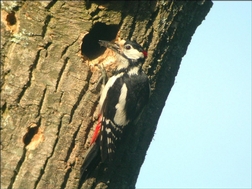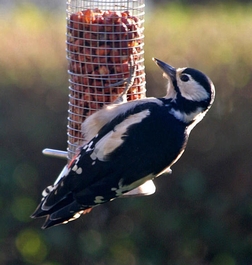Great Spotted Woodpecker



These striking black and white birds with the bright red vent are making appearances at garden feeders throughout Arran and their drumming is becoming a familiar feature of Arran woodlands. This year already there have been reports from north, south, east and west, namely from Lochranza to Kildonan and from Whiting Bay to Shiskine often with comments like "Where have these birds come from? I have lived here all my days and I have never seen them before."
The species is believed to have been widely distributed in Scotland prior to the destruction of indigenous forests. In the first half of the nineteenth century there was a rapid decline and by the middle of the century Great Spotted Woodpecker was considered to be exterminated. This was attributed to clearance of woodland. Competition with Starlings over nest holes and predation by red squirrels were possibly also important as both their populations were increasing at the time. During the later 19th century, following a northwards expansion from England, breeding was recorded in Solway 1888, Duns, Berwickshire 1893, and by the turn of the century in Central Scotland. Within fifty years all mainland Scotland recording areas had breeding populations. This is according to Birds of Scotland: editor R. Forrester et al ( SOC 2007). The first Ayrshire breeding record was in 1925 as noted in the Birds of the Firth of Clyde: J.M. McWilliams (Witherby 1936), and according to Birds of Scotland: E.V. Baxter and L.J. Rintoul ( Oliver and Boyd 1953) the only island on which it was known to breed was Bute, with nesting since 1938.
What about Arran? According to Birds of Arran: R.Gray ( Bell and Bain 1872) there were no Arran records and according to Birds of the Firth of Clyde:J.M. McWilliam ( Witherby 1936) there were no Arran records. However Birds of the Island of Arran: J.A. Gibson ( Bute Newspapers 1956) states…"Great Spotted Woodpecker now nests not uncommonly in the woods around Brodick." Maggie Dunn, a previous bird recorder for the Arran Natural History Society, has some records from around that time but the population does not seem to have become established. Perhaps at that time there was not enough appropriate woodland. From the annual Arran Bird Report in the 1980s and 1990s there were only five occasional records mainly from the Brodick area. This century the first record was in 2002 in Merkland Wood. There were also records in 2003 and 2004, and in 2005 there was the first confirmed breeding record in Kilmichael, Brodick. From this stronghold round Brodick, over the next few years there were increasingly widespread reports and the species now seems to be well established on Arran.
Great Spotted Woodpecker is distributed over an immense range covering almost the entire Palearctic from Britain in the west to Japan in the east and reaching North Africa and the Canary Islands in the south-west.
When searching for food the Great Spotted Woodpecker usually alights on the trunk then works upwards and often from side to side. During the ascent it smartly taps the bark, prising off fragments and frequently extracting food from crevices with the tip of its sticky tongue. Actions are jerky and the bird hops rather than climbs even when beneath a branch. It will work round to the further side of the trunk, often apparently to avoid observation. It has a varied diet changing with the seasons. During spring and summer it feeds largely on insects, especially ants and the larvae of wood-boring beetles. Holes may be chiseled up to four inches deep. But in autumn and winter the birds switch to a variety of fruits, seeds and nuts. Unwieldy nuts and pinecones are placed in clefts and hammered open with the bill. Particular trees are selected and the remains of food may be found scattered below these "anvil" trees.
Great Spotted Woodpeckers are also notorious for taking the eggs and young of other hole-nesting birds like tits and House Martins.
Its presence is often advertised by the mechanical drumming, a vibrating rattle, produced by the rapidly repeated blows of strong bill upon a trunk or branch. This is not a dedicated courtship call or challenge, but a signal from either sex to announce its presence. It is audible from a great distance, depending on the wind and the condition of the wood; a hollow bough naturally producing a louder note than living wood. The drumming sound produced by the woodpecker relies not so much on a heavy knock, but rather on the correct frequency of knocks (10-40 strikes per second) to make the timber resonate. Do not try this. Unlike us, these birds have shock-absorbent tissue at the base of the skull.
The birds are monogamous, pairing from January to July. The initial contact is established through drumming. Both sexes excavate the nest hole. This can take two to four weeks starting in March and April, with a strong preference for dead trees. A single brood of four to seven eggs is laid in April to June and both adults incubate. Eggs hatch in about 15 days and the young fledge in about 22 days. Young are divided between parents to form loose units that move within the territory for about three weeks before independence.
To tell the males from the females look at the back of the neck. Males have a crimson spot on the nape, which is absent in females and juvenile birds. Later in the summer look out for young birds coming to feeders. These young birds have a crimson crown.